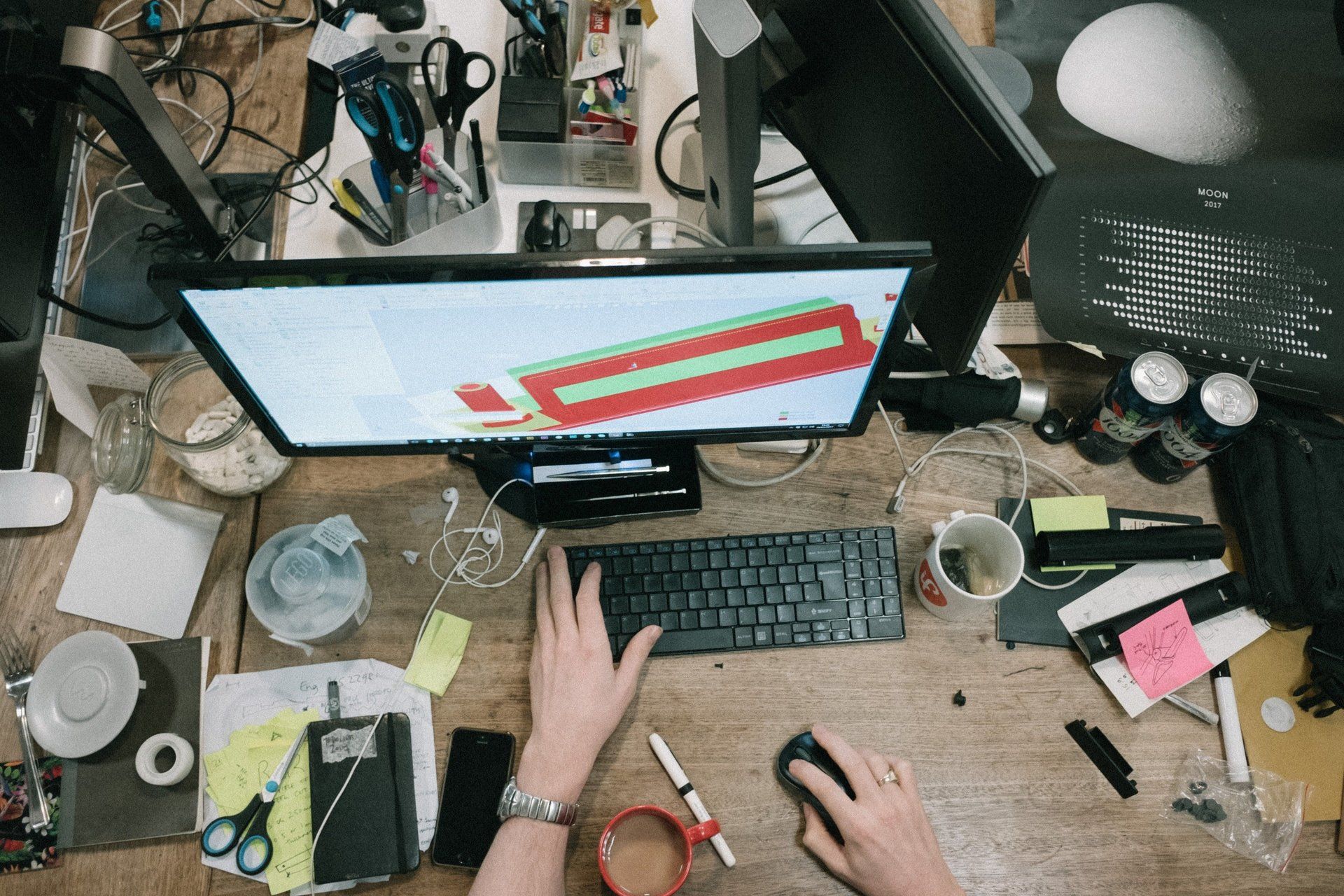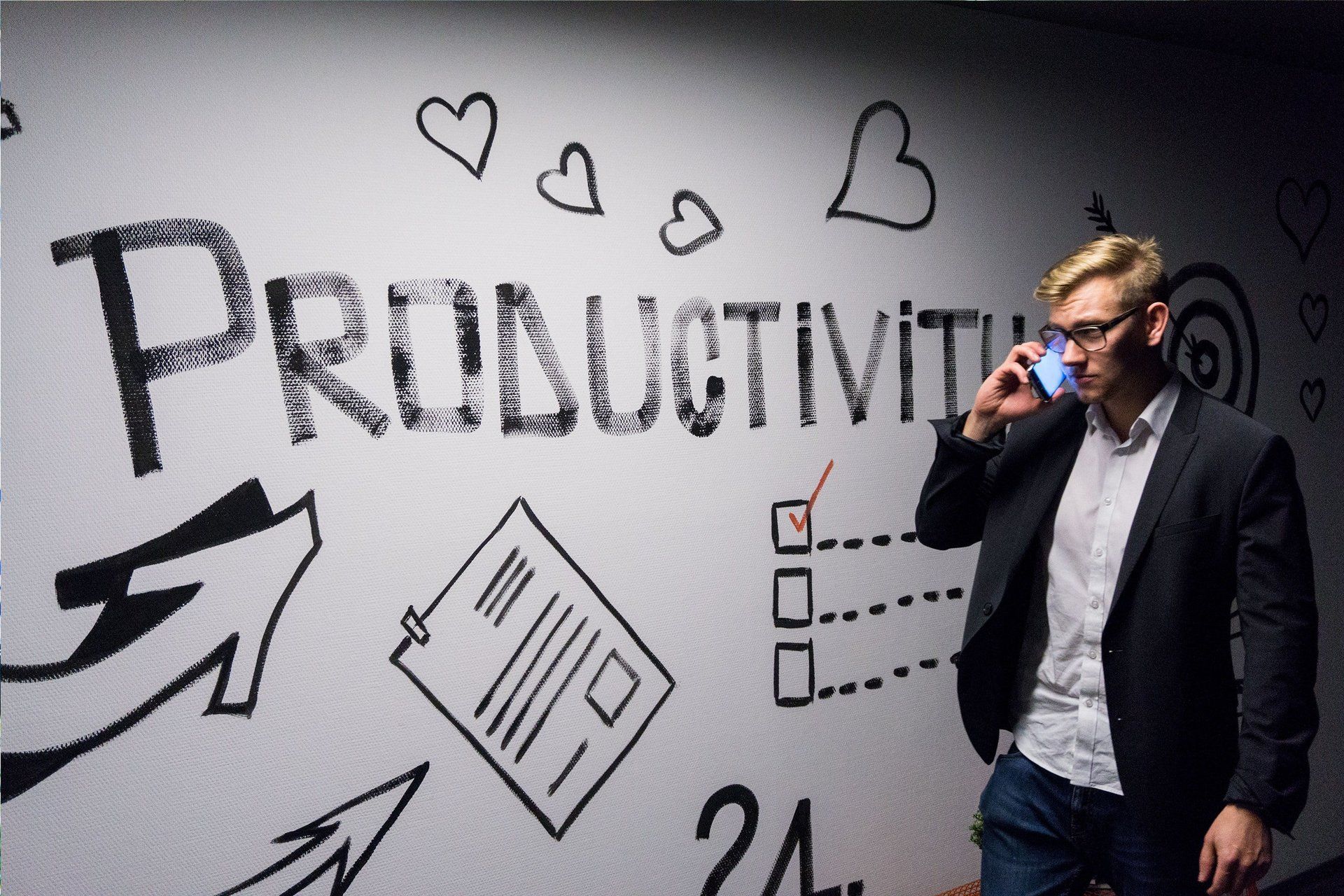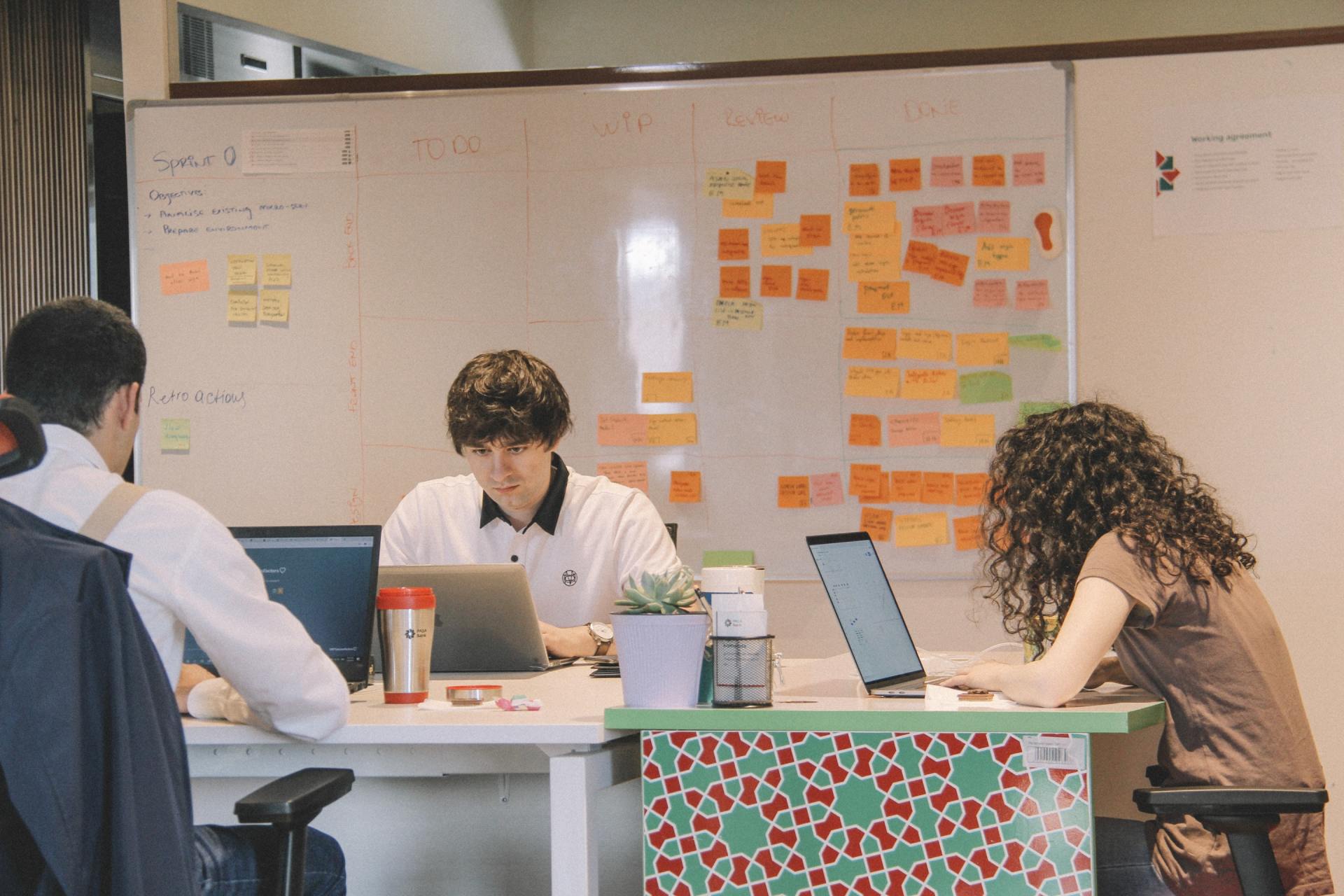BLOG

Productivity is more than just doing more with the time you have. Unless what you produce is linked to what you are trying to achieve, doing more in your allotted time frame is just producing more stuff. You risk using up your energy on irrelevant activity. If you’re going to be busy, be busy with purpose. Purpose Defining your purpose makes productivity relevant and easy. Define your daily purpose (what gets you out of bed each day?) and your long-term purpose (what is the big picture that you are working towards?). Break your purpose down into concrete goals. Break the goals down into specific action steps. Then act. If you do it this way, your everyday actions become filled with meaning, energy and direction. Here’s another way to look at purpose. What is your “product” purpose and what is your “process” purpose? A product purpose includes the concrete, tangible results you are creating, such as goods and services. Process purposes are intangibles, such as bringing enjoyment, satisfaction, kindness and enthusiasm to the people you encounter. If you wake up every day with this kind of process purpose, you can achieve it every day. Make sure your big picture is high enough up the chain. For example, you may think that your one business idea is your big picture. Dig a little deeper, and you might discover that it’s financial security for your family. This a helpful because it means that if your one business idea fails to deliver, your big picture is not smashed. It just needs different brush strokes: there will always be other ways to achieve it. An incidental benefit of this method is that you can relax a little: you can keep your commitment to your big picture, but you don’t have to hold on for grim death to one method of achieving your goal. High Participation/Low Attachment I constantly use the Participation/Attachment model. It’s useful when you want to play big without the stress of all-or-nothing thinking. There are four quadrants in this model. I’ll use an analogy to explain it. You are watching a football match from the sidelines and you don’t care who wins. This is Low Participation (you are not playing) and Low Attachment (you don’t care about the outcome). You are a spectator, but you have a $10,000 bet on the outcome. This is Low Participation (you have no influence over the game) and High Attachment (you really care about the outcome). You are playing on the team, and your entire football career depends on the outcome of this one game. This is High Participation/High Attachment. This leaves the High Participation/Low Attachment quadrant, which is where you want to play and work. Give your one business idea your best shot but let go of the outcome. There are plenty of ways to achieve your big picture purpose, and you can enjoy your daily process purpose along the way. Once you’ve got your purpose(s) sorted, keep it simple. Get your priorities straight, then label items on your ‘to-do’ list with A or B. A’s must get done today. B’s get done if time allows. Some B’s that miss out today will become A’s tomorrow. Getting frustrated when things go wrong or don’t happen in your preferred time frame can be sign that you are playing the wrong quadrant. Impatience and frustration will not make you more productive. In fact, they can slow you down and impact your judgement. Not to mention your relationships with coworkers, staff and family members. Keep your eyes on the prize, but slow down and enjoy the journey. Otherwise, what’s the point? After all, if you lose the “game” you’re in, there are always other games, other teams, other sports.

Improving your productivity is easy. Add just one of these strategies to your working day and see what a difference it makes to your sense of control (it will go up) and your stress levels (they will go down). Add a new strategy each week or each month, until they become habits. The habits will change how you work and play. Checklists For regular, ongoing tasks and projects, create a checklist so that you don’t have to rely on your memory. Just check the list and do what comes next. Operating theatres and car servicers are experts and they use checklists because they cannot afford to miss anything. Follow their example. Choice Every day, every hour, every minute we exercise our ‘choice’ muscle. Not choosing turns out to be a choice too. Practising pro-active choice gets easier and easier, and we get more and more done. Clarity Clarity is power. The clearer you are about your desired outcome, the greater the possibility of achieving it. Be specific. You don’t want a vague almost-there result. You want to nail it.
Clear your mind. Clock Have a clock visible so you can keep track of the time. Use it to help you be on time. Cloud-based Use a ‘cloud-based’ system to store your data (for example, One Note, Evernote, iCloud, Google). This way, if something nasty happens to your personal system (paper-based or computer- based) you can retrieve it using any computer, or even access it via your phone. Remember to back up regularly to the ‘cloud’. Take photographs of important paper-based data and, again, save them to the cloud. Coach Get a coach. Your productivity will soar when you allow an expert to come alongside to motivate, encourage, share their knowledge with and stretch you. Coffee nap A coffee nap is a simple secret to a more productive day. Drink a cup of coffee, wait ten minutes, then have a 20-minute sleep – no more and no less. Set an alarm – the exact amount of time is important for your ‘sleep cycle’, otherwise you will wake up groggy. Comfort zones Comfort zones are made to be stretched. To become more productive, go beyond what is safe and comfortable. Try something new to create a better result, a great experience, and an exhilarating life. Dare to risk. Don’t overdo it, however. Stretch a little, but not too much – you don’t want to fly past the healthy stretch zone into the paralysing ‘panic’ zone. Communicate Productivity and running to time go hand in hand, but sometimes the schedule blows out. When this affects other people, keep them in the loop. This simple courtesy gives them the chance to adjust their own schedule. More importantly, it keeps the relationship intact. Concentrate Set up your environment to help you concentrate. Turn off notification ‘pings’ on Facebook, Instagram, Snapchat and email (computer and phone). Recent studies have shown that a single-task focus is more productive than multi-tasking, so pick one task, screen off everything else, set a time limit for completion, and go for it. Context Divide your tasks according to their context. Assign them to your customised categories. That way, when it’s time to ‘make phone calls’, or ‘go to the supermarket’, or ‘talk to the boss’, you have a list of tasks in that context ready to execute. Control W e all need a sense of control. If you are feeling helpless, re- think the situation. Don’t assume there’s nothing you can do.

I Don’t Procrastinate…Do I? Wonder why things aren’t getting done? Could procrastination be the problem? What is it and why is it stopping us from creating what we want? The definition of procrastination is “the act or habit of procrastinating, or putting off or delaying, especially something requiring immediate attention” Joseph Heller said, “Procrastination is the thief of time.” It’s thinking too much and not acting, which results in you not moving forward. What causes procrastination? – There are several possibilities: Maybe you are waiting for the right time. Do not wait, the time will never be "just right". Start where you stand and work with whatever tools you may have at your command and better tools will be found as you go along - Napoleon Hill Maybe you are not clear on what it is that you want to achieve or perhaps not clear on the steps to take to achieve it. You may be overwhelmed with the sheer magnitude of the tasks set before you. This can also keep you stuck. If you have started tasks and not completed them. Thinking of ideas and not acting on them can contribute to procrastination. A lack of thorough planning can lead to procrastination, as can a lack of purpose (why am I doing this anyway?) How do you know if you procrastinate? Asking yourself “am I getting things done?” is the simplest way to find out. Do you have a long list of unfinished tasks? Are there emails that you resist taking action on? Do you beat yourself up for not making a decision on things? What can be done to overcome procrastination? Firstly, be willing to make decisions. “Be willing to make decisions ... Don't fall victim to what I call the "ready - aim - aim - aim" syndrome. You must be willing to fire” - T. Boone Pickins You may not think of yourself as a leader, but you are. You are leading your life. As a leader, you need to be making decisions. Good or bad. Right or wrong. Make that decision; if it is wrong, fix it later. Be bold. Be brave. Choose to start. Don’t let your ideas just be ideas and your dreams just be dreams. Start, and see what happens. “The way to get started is to quit talking and begin doing” - Walt Disney Take action. Any action. And keep taking action. Choose and act. Choose and act. One school of thought is “take massive action”. Can you ramp things up? Can you increase your output? You never know how much you can get done. You never know the impact of the actions you take until you take them. Action is the foundational key to all success - Pablo Picasso Never leave till tomorrow that which you can do today - Benjamin Franklin Now is the watchword of the wise - Charles Spurgeon Ask yourself “Did I do what I said I was going to do? Am I keeping my word to myself? Do I have integrity … with myself?” Keeping your word to yourself has a significant role in increasing self-esteem and self-belief. “I said I was going to do it, and I did it. What’s next?” Finally, your problem may simply be that you lack the knowledge or resources to move forward. To think too long about doing a thing often becomes it's undoing - Eva Young

Purpose Defining your purpose makes productivity relevant and easy. Define your daily purpose (what gets you out of bed each day?) and your long-term purpose (what is the big picture that you are working towards?). Break your purpose down into concrete goals. Break the goals down into specific action steps. Then act. If you do it this way, your everyday actions become filled with meaning, energy and direction. Passion What you are passionate about, you will do more of. Discover and clarify your passions. Make room for them in your week. Productivity Tackle the most demanding tasks in the most productive time of your day. If your energy is high first thing in the morning, schedule the tough tasks in the morning. Or if you take time to ‘warm up’ to your day, schedule the challenging jobs for the afternoon. Progress There is a difference between being busy and making progress. Are your days busy but not moving you towards your goals? How are you measuring your progress? Revving the engine might feel good and sound good, but when the car is in neutral it ain’t going anywhere. Patience Getting frustrated when things go wrong or don’t happen in your preferred time frame will not get them done any quicker. In fact, frustration and impatience can slow you down. Keep your eyes on the prize, but slow down and enjoy the journey. Perfectionism Perfectionism will paralyse you. Go for excellence instead. Believe in trial and error. Understand that you can ‘fail forward’ (Courtesy John Maxwell). Plan, plan, plan You may want to skip planning your day and ‘just get on with it’. However this is false economy. The best time to plan is the night before - it primes your unconscious for alerting you to things you may have missed or a problem that needs solving. By sleeping on it, you will most likely wake up with a solution. This is the effortless way to fuel massive action. Planning Plan the day, the day before. Map out the tasks for tomorrow. If you give yourself 15 minutes to do this at the end of your workday, before you leave the office, you can catch any problems/clashes/needs in advance. Pomodoro Technique Developed by Francesco Cirillo, the Pomodoro technique uses a timer to break work down into 25-minute intervals and then a five-minute break. Check it out. Positive Do you focus on the positives, or do the negatives rule your life? It takes ten positives to counteract the effects of one negative. Negatives can give you useful feedback. Then focus on the positive to propel yourself to action. (see Up) Practice The old adage that practice makes perfect is not quite accurate. Perfect practice makes perfect. Get feedback, make corrections and do it again. Repeat your way to excellence. Priorities Get your priorities straight, then label items on your ‘to-do’ list with A or B. A’s must get done today. B’s get done if time allows. Some B’s that miss out today will become A’s tomorrow. Procrastination P rocrastination is the result of over-thinking and under-doing. Joseph Heller said, “Procrastination is the thief of time.” Take action. If you are stuck, try any action. Choose and act. There are many causes of procrastination, but only one solution: taking action - now!

What would you do with one extra hour each day? Spend more time with the kids? Exercise? Start a project? Sleep? Whether it’s for relationships, ambition or health, getting back an hour in every day is entirely achievable. In fact, you can start today. There’s a model I teach in my training seminars which I call ALTA. It represents a four-step process for changing habits, be they professional or personal. ALTA stands for: Awareness (of what needs changing); Leadership (taking responsibility and taking charge); Tools (could be information, objects, technology or people); and Action (Do THE Thing!). Let’s look at an example of ALTA. A friend of mine (let’s call him Michael) mentioned recently that he wanted to save money. After doing a quick audit of his daily spending, he realised how much money he was spending on buying his lunch every day. With this Awareness, Michael took Leadership by deciding that he wanted to start bringing his lunch from home four days a week. He spoke to his domestic partner (am I allowed to call her a Tool?), and together they evaluated their grocery shopping budget and routine. Their solution? When preparing dinner, they would ‘cook double’, packing the extra portions into Tupperware ready for tomorrow’s lunch. The final piece of the Action puzzle was setting up a system so that Michael wouldn’t forget to grab his lunch from the fridge each morning (in this case, he set up a daily alarm on his iWatch). What does ALTA have to do with getting back an hour in every day? Well, time is a finite resource. There will always be 24 hours in each day. So, in order to get an extra hour, we’re going to need to find it and take it from somewhere else. This requires us to change some habits. Here are four time-management challenges that come up again and again for small business operators, and Tools you might find useful. As you read through the Tools of Planning the Day, Prioritising, and Establishing Daily Routines below, start with simple Awareness. Reflect on your own routines and habits. Planning the Day You may be tempted to skip planning your day and ‘just get on with it’. However, this is false economy. The best time to plan is the night before. If you give yourself 15 minutes to do this at the end of your workday, before you leave the office, you can catch any problems, clashes or needs in advance. Planning the day before also primes your unconscious for alerting you to things you may have missed or a problem that needs solving. By sleeping on it, you may even wake up with a solution. This is the effortless way to fuel massive action. Prioritising One of the main reasons people, particularly small business owners, don’t have enough time is because we’ve over-filled our schedules. No gaps. No down time. Why do we take on too much? Sometimes it’s FOMO – Fear of Missing Out. Some of us find it difficult to say ‘no’. Sometimes we take on too much because we haven’t considered what’s really important to us. Whatever the cause for our feeling stretched thin, reducing our focus to what’s important gives our schedule the flexibility it needs to not only allow for down time, but also to deal with the unexpected without throwing out our entire day. Set achievable to-do lists, not 100 tasks to be done in one day. With 100 tasks, you are just setting yourself up for disappointment and frustration. Choose ten to 15 tasks and prioritise them. A simple prioritisation method is A’s and B’s. An A task must get done today, and B tasks would be nice to get done today, but if they need to be bumped to tomorrow, so be it. Stay focused on the A’s until you get them done. “Oh, but this B looks fun and will only take 10 minutes”, we say to ourselves, only to realise 45 minutes later that we’re elbows deep in a B and now have to stay late to get all those A’s done. A’s are what matter. Do them first. If your 15 tasks get done, add a couple more. Another way to help you stick to your priorities is to have boundaries. How comfortable are you with saying ‘no’? Do you find yourself caught up in long conversations that you need to leave, but don’t know how? Establishing boundaries may feel uncomfortable at first, but this will change with time and practice. Learning how to say ‘no’ with diplomacy is not only achievable, it’s a trait of good leadership. What would you say to a colleague who kept interrupting you in your office to chat? For a lot of people, the answer would be “nothing”. Here are some alternatives that I’ve heard people use: “That doesn’t work for me now, but it could work in two to three hours. Check back in with me then.” “I’m keen to have this discussion, but I’m up against a deadline right now. Can we schedule a catch-up for tomorrow?” “I want to give this my full concentration, but my mind is stuck on some urgent tasks I have. Let’s lock in a time that works for both of us.” Establishing Daily Routines One challenge I often hear from small business operators is about the need to streamline tasks. Small business owners are in a unique position where they are responsible for keeping many plates spinning. One way to streamline is to establish daily routines and make them habitual. Habits are simply acquired patterns of behavior that have become almost involuntary. The four stages of competence model can help us track our progression through the stages of habit formation. To understand how the four stages of competence works, let’s use an example. 15-year-old Emma has been playing car-racing video games for years. She thinks she knows how to drive, although she has never been behind the wheel of an actual vehicle. This is Unconscious Incompetence, the first stage. Unconscious Incompetence means that Emma can’t drive, but she doesn’t know it. On her 16 th birthday, Emma sits in the driver’s seat of her parents’ Volvo wagon and realizes she has no idea what she’s doing. This is stage two: Conscious Incompetence. She can’t drive, and now she knows it. After a period of practice, Emma is now able to drive from A to B safely, but she still needs to concentrate. This is the third stage, Conscious Competence. Eventually, Emma has her first “I don’t even remember driving here” experience, indicating that her driving has become automatic, taking up minimal conscious effort. Emma has now reached the fourth stage; she is an Unconsciously Competent driver. Acquiring new behaviour patterns is similar. Understanding the four stages of competence model will help you to understand what to expect as you establish a new habit or routine. Don’t be discouraged. Be consistent, but more importantly, be patient. It takes time to go from conscious effort to autopilot, but remember, good habits are like slow-cookers: you can set and forget. Maybe as you read this article, you became Aware that you don’t have strong boundaries. Maybe you even found some Tools that you can use to help you say ‘no’. It’s now time to exercise your Leadership. Choose one thing that you want to make a habit or include (or exclude) from your daily routine. What Tools can you use? Finally, Do The Thing! Put your Leadership into Action, and get back that hour.

You’ve done the right thing and set some business and personal goals for the year. You may have set some financial targets, created flowcharts and set up tracking systems. Now, a month into 2019, you may feel frustrated that despite your best intentions, you are not being as productive as you had planned. Time just seems to slip away. Here are some simple, easy-to-implement strategies to help you claw back some control and get traction on those good intentions. Meetings Start on time. Finish on time. Stick to the agreed agenda. This is respectful to everyone who attends. For agenda items that don’t get handled, bump them to the next scheduled meeting. Attendees will learn very quickly to stay on point if their precious item didn’t get addressed. If you want to go really hard, hold your meetings in a room where there are no chairs. Or standing up on the shop floor before you open the doors to the public. If you do it before coffee, the meeting will fly like the wind. Interruptions Become aware of what interrupts your flow or breaks your concentration. Make a conscious choice about which interruptions to allow and which to refuse. Put yourself in control. Put a good old-fashioned Do Not Disturb sign on the door. Ask someone else to take your phone and take messages for the next hour or three. Take yourself off to the anonymity of a coffee shop when you need to plan or be creative. Make sure you have communicated to those who matter the reason for your new-found boundaries. This way you will get their support, not their suspicions! Saying No Saying “no” will establish clear boundaries. Someone else’s ‘urgent’ doesn’t have to become your ‘important’. Saying “no” with diplomacy and firmness takes practice, but it’s all about how you communicate. When it comes to distractions and unhelpful habits, respect your own boundaries – say “no” to yourself. Get support with this by making yourself accountable to someone. If you’re serious about breaking an unhelpful habit, use the Money-In-the-Swear-Jar principle: set up a system where it hurts every time you do it. (Missed a session at the gym? Pay your wife $50. You get the idea). Distractions Distractions are the enemy of productivity. Know your enemy: what distractions are you vulnerable to? Checking emails or social media or the news too often? Getting involved in other people’s problems? Reduce or eliminate those activities that do not move you closer to your goal. You can’t do big things if you are distracted by small things. Starve your distractions, feed your focus. Take Regular Breaks No matter how busy you are or under the pump you feel, make sure you plan – and take – regular breaks throughout the day. This one may sound counterproductive, but breaks restore your energy, which will increase the quality and quantity of your workday’s output. Go for a walk. It will get some oxygen to your brain. Ideas will pop. Solutions to problems will float to the surface effortlessly. (Hint: leave all devices at your desk). Coffee Nap A coffee nap is a simple secret to a more productive day. Drink a cup of coffee, wait ten minutes, then have a 20-minute sleep – no more and no less. Set an alarm- the exact amount of time is important for your sleep cycle – otherwise you will wake up groggy. Your brain and physiology will be refreshed and re-set, enabling you to go again.

Planning Plan the day, the day before. Map out the tasks for tomorrow. If you give yourself 15 minutes to do this at the end of your workday, before you leave the office, you can catch any problems/clashes/needs in advance. Priorities Get your priorities straight, then label items on your ‘to-do’ list with A or B. A’s must get done today. B’s get done if time allows. Some B’s that miss out today will become A’s tomorrow. Patience Getting frustrated when things go wrong or don’t happen in your preferred time frame will not get them done any quicker. In fact, frustration and impatience can slow you down. Keep your eyes on the prize, but slow down and enjoy the journey. Pomodoro Technique Developed by Francesco Cirillo, the Pomodoro technique uses a timer to break work down into 25-minute intervals and then a five-minute break. Check it out.

You’ve hit your straps this year. The motor’s well and truly warmed up, even though it’s getting cold outside. Here are some quick and simple tips to streamline you for peak productivity, because small things done consistently in strategical places create major impact. Make Time Can you manufacture more time? No. What you can do is change your schedule and priorities to make room for the tasks you want to undertake and the results you want to create. Make your bed This one simple task, completed, can snowball into an energised and productive day. Plus it’s nicer to get into a well-made bed at the end of a productive day. Manage yourself It’s very easy to blame someone or something for your lack of time. You need to take personal responsibility for your life and outcomes. How do you manage yourself? Have systems, routines and discipline. Keep your agreements, including with yourself. Manage your workspace Keep your workspace orderly. Have the essentials within reach. Keep a clean and clear space to do the work. Pack away anything that does not absolutely have to be on your desk/in the car/on the shelf. Be ruthless. A clear and orderly space supports a clear and orderly mind. Meditation/Prayer/Solitude We all need time to ‘unplug’. Take time to retreat and contemplate. Let your mind wander. If, in the process, something important drifts up, write it down. Let your mind wander again. Repeat. Meetings Start on time. Finish on time. Stick to the agreed agenda. Enough said. (Hint: If your meetings tend to drag on, have them in a room where there are no chairs - that will shorten them! Stand- up meetings rock!). Mentoring If you need help, ask. Find a mentor for guidance and encouragement. Choose someone who has been where you are, has put in the work and who demonstrates the kind of success you want for yourself. Minutes There are 60 seconds in every minute. Make them count. There are 60 minutes in every hour. Make them count. Time doesn’t stop. What can you do in one minute? List those things that can be accomplished in blocks of two, five, ten, 20, 30 minutes. When you have a gap between activities, check your list, pick an action and do it. You will be surprised and pleased at how you can chip away at that list. Mistakes Don’t let the fear of making mistakes stop you from taking action. Life is full of mistakes (it’s how we all learned to walk, after all). Learn from your mistake and try again. Label it ‘learning’ rather than ‘failure’. Morning A lot can be achieved first thing in the morning before the day fully begins. This is where that extra time can most easily be found. Get up earlier than normal and get into the day. Morning achievements turn into momentum for the afternoon and evening. Motivation Motivation provides the compelling reason to take action. Know your motivation. It will transform your ‘just thinking about it’ to ‘I will get this done’. Multi-tasking Once touted as efficient, research now shows that multi-tasking creates distractions, slip-ups and diluted focus. Try mono-tasking: set up a block of time to allow yourself time to concentrate on one task, and see it through to the end (20 minutes, 30 minutes, an hour). Don’t deviate until it’s done. Eliminate as many distractions as possible and go for it. The result will be achieved more efficiently, the quality of the result will be superior and you will most likely enjoy the process more.

Every business owner knows they must manage their time when it comes to appointments, production schedules and deadlines. The difference between success and failure – profit, break-even or loss - can hang on how we spend the precious finite resource that is our time. But just like cleaning our teeth, how well we do it can vary. A cursory ten-second sweep around the inside of your mouth with a toothbrush could technically be called cleaning your teeth, but what have you missed? As your dentist will tell you, there’s always room for improvement. As the Time Lord, my aim is to give you some expert tips to help you operate at optimum. Here goes… Allow for the Unexpected Plan your day to include gaps that allow for interruptions or a crisis. If these show up, you will be prepared to handle them. Without space in your day, you can become flustered, annoyed or panicky. This is when mistakes happen – you can waste precious time when you need do things over or go into damage control with a client. Plus, it can make you a very unpleasant boss to be around. Protect your workplace morale. It can have an impact on your staff’s productivity. If you have one of those golden days in business where nothing unexpected happens, you will have built in time to develop that new project you’ve been meaning to start, or put your feet up to rest, think, create. Don’t ‘jam-pack’ your day. Schedule gaps in the diary. Which brings me to… Use a Diary System Some people don’t have a diary at all – they try to keep it all in their head. Some have a diary but all it does is collect dust on the desk. Some use a diary, but so inconsistently that it gives a false sense of security because not every appointment or event is recorded in it. Setting up and maintaining a diary system is a commitment of effort and time, but the rewards are worth it. You will free up mental space, gain a sense of control, and increase your energy and motivation. You can run your whole life, with all its different domains and areas of responsibility, out of a diary system. A diary can be as simple or complex as you like. It can be paper-based or app-based. Even a spiral-bound notebook, or a loose-leaf binder is okay. You can even download a template and design your own. Experiment. Have fun with it. Delegate Successfully A diary system, properly used, will quickly reveal where you are overloaded with tasks and responsibilities. You’ll see it in black and white, and you will feel it: the pressure building in your head, the energy draining out of the bottom of your feet, the shallow breathing. It’s time to delegate. I know, I know. It’s scary. As a small to medium business-owner, you know that if you do it yourself it will be done right. But you will get worn out, and your business will struggle to grow. Delegation produces leverage – you can double or triple your productivity. Successful delegation requires assigning the right task to the right person, being clear in your instructions, and following up for quality control and completion. Use the time and energy freed up to do the tasks you do best and the things only you can do. It might be designing new products, creating new clients or strengthening relationships with your key stakeholders. Add these new techniques, one at a time. Start by using toothpaste. Move on to brushing for longer. Incorporate mouthwash. Then start flossing. Just like cleaning your teeth, learning and applying new time-management tools is an investment in the long-term health of your business.

It’s ironic that technology, invented to save us time, money and energy can end up becoming a double-edged sword. Email is one example of a small element of your business day that can impact your productivity in significant ways, both positively and negatively. Email is obviously faster and cheaper than letter, stamp and next-day postal delivery. But the fact that it’s faster and cheaper means people can “post” you junk that they wouldn’t invest in a letter, stamp and trip to the post box. Consequently, email can get out of hand, and it often seems like a mountain of a task to get it back under control. It has become a distraction in itself: email notifications pop up throughout the day, demanding our immediate attention. Achieving Inbox Zero Developed by Merlin Mann, Inbox Zero is a rigorous approach to email management aimed at keeping the inbox empty—or almost empty—at all times. Inbox Zero helps to eliminate distractions, reduce the time spent sifting through email detritus, declutter your screen (and your brain), and perhaps most importantly, Inbox Zero gives you a sense of control and achievement which extends beyond the screen. There are many ways to achieve Inbox Zero, but I will share with you my method. When an email appears in my inbox, I follow the four Ds: Do – can I action this in under two minutes? If yes, do it immediately. Dump – is this junk? Get rid of it immediately. Delegate – if it doesn’t fit into your area of responsibility, delegate it immediately. Decide when – if actioning the email will take longer than two minutes, decide when you will do it instead. Set an alarm or schedule an appointment in your calendar. Some people love to get to Inbox Zero daily. For others, this seems daunting, and many instead aim for 5pm on Friday. Whichever way works for you, the feeling of leaving work for the day (or the weekend) knowing you’re at Inbox Zero is sweet. Give it a try! Managing Email Hacks Only check your email a few times a day, or once an hour, on the hour. Add a line under your email signature that says something like “I only check my emails three or four times a day. If it’s urgent, please call me or walk around to my desk and see me”. This may not work for everyone, but if applied, it will give you control over email, rather than the other way around. Close your email client down when you want to focus on other tasks. Down tools at the end of the day. Choose a time to finish and set an alarm so that you do finish. Then, don’t check your emails while you’re away from work. If that is not possible, choose a time (and duration) to check them away from work, and stick to it, for example 8pm for 15 minutes. Finally, if you can’t close your email client down, at least turn your notifications off. There’s an hour back just from eliminating distracting pop-ups. Email Overwhelm Does your email inbox feel overwhelming? Do you feel like you’re always on the back foot when it comes to dealing with email? Apart from the amount of time it takes to attend to each email, it can be a drain on your energy, in a couple ways. Firstly, irritation with unsolicited “deliveries” can become major frustration and even anger. We start putting emotional energy into the thing, especially when we try to “unsubscribe”, and the addressee makes it difficult and laborious. Secondly, our energy is drained just by seeing emails sitting there in the Inbox. Once you have achieved Inbox Zero for the first time and experience the rush of energy you’ve made available, you’ll know what I mean. Now… go forth and conquer your email.

